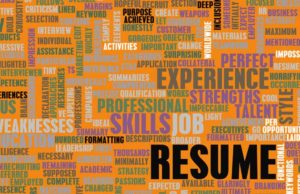 Answer: An increasing emphasis on hiring to meet Diversity & Inclusion (D&I) initiatives is affecting how to present your capabilities, work and life experiences in a resume. How can you tell a more comprehensive story about your qualifications that don’t fit traditional categories? Here is #3 in the resume series about D&I hiring trends that affect how you craft your resume.
Answer: An increasing emphasis on hiring to meet Diversity & Inclusion (D&I) initiatives is affecting how to present your capabilities, work and life experiences in a resume. How can you tell a more comprehensive story about your qualifications that don’t fit traditional categories? Here is #3 in the resume series about D&I hiring trends that affect how you craft your resume.
There isn’t just one solution. Stories that make the point and cover letters that are tailored to the situation are possible answers. This is new territory and I’ll be interested in feedback. Here is my answer. Do you agree?
As greater emphasis is put on agencies and companies to adopt D&I programs for bottom-line returns, token efforts are being replaced by far more impactful and costly initiatives. The pressure is on to hire and retain excellent performers from diverse backgrounds. Here is a snapshot of where we are. Read what candidates should include when they describe their backgrounds and experiences that qualify them for positions where diversity is a key qualification.
For well over 40-years the national Public Relations Society of America has had a policy supporting what was originally called Affirmative Action (AA) encouraging the hire of specific ethnic groups such as African Americans, Hispanic, Asian and Native Americans. Check enough boxes and you were in compliance, meeting your AA goals.
These efforts were ineffective despite an acknowledgment that this objective was important for the industry to address. That simplistic and limited view has been supplanted by D&I initiatives. Here are how these terms are defined.
“Diversity is the range of human differences, including but not limited to race, ethnicity, gender, gender identity, sexual orientation, age, social class, physical ability or attributes, religious or ethical values system, national origin, and political beliefs.
“Inclusion is involvement and empowerment, where the inherent worth and dignity of people are recognized. An inclusive {organization} promotes and sustains a sense of belonging; it values and practices respect for the talents, beliefs, backgrounds, and ways of living of its members.” Source: Ferris State University.
In a 2017 article in the Holmes Report (Diversity is an on-going topic covered) reporters speculated about the lack of effective action to meet D&I goals. They questioned whether consulting firms could ever succeed in hiring significant numbers of diverse staffers, not only at entry-level but at senior ranks as well.
Within the past year, several major corporations have inserted D&I requirements in their RFPs asking if top tier agencies have diverse staffs reflecting the communities they serve. Potential clients are asking for specific numbers. From D&I initiatives seen as one of many important goals for these agencies, now, they are becoming specific bottom-line necessities.
Major global and consumer product companies are examining their own internal practices. They are making serious efforts to not only hire from a diverse candidate pool but to institute programs to foster an inclusive work place. The challenge is not only to identify diverse talent but also to provide an environment that welcomes and supports them. (I wrote a report on this subject that is available upon request, please email me with “D&I report” in the subject line. jcushman@jc-a.com)
With the focus on Diversity that is so broadly defined, job seekers can present credentials in many categories, e.g. educational, personal life experiences, language and travel as well as his/her ethnic and racial background. Participating in organizations representing ethnic groups is useful as well. These are all valid examples that indicate a candidate qualifies as meeting diversity criteria. How can this information be presented prominently in a resume? It certainly doesn’t fit the classic format of a resume..
In the past, including language ability, for example, was an afterthought at the end of a resume. Now, that is highly desirable. Global business assignments especially if you resided in a country overseas are also very helpful.
I have already said a resume needs to be brief, targeted and impactful. The key is to start with an objective or summary statement about your career that indicates your background experience is global (or whatever is the strongest element in your portfolio) fitting diversity criteria.
If a great deal of the experience is personal, I would insert a special section somewhere on the first page where it will be read that says, “Supporting experience relating to Diversity objectives.” I think that is the way to use the strongest elements, based on all the personal and business experience you have, to make your case.
If you have had overseas responsibilities, be sure to include that in the stories you are incorporating into the resume. It may be challenging to arrange these elements for the strongest impact. Please email me with specific questions.
There is another approach that will also work. If you are happy with the resume and it does not highlight your D&I experience, consider creating a separate cover letter. It would describe your specific D&I experience that applies to the job description.
We are still at the beginning of a what will be a long-term solution to bringing change to our industry. Hiring managers will be challenged to rethink how they evaluate candidates since their instincts have been honed to look for compatibility and fit. That leads to sameness—no doubt qualified candidates– but not adding the value that is needed in the diverse, global environment we operate in today. It will be a difficult path as old habits and instincts must be replaced with more rigor and a new approach to finding candidates with the appropriate credentials to succeed.
